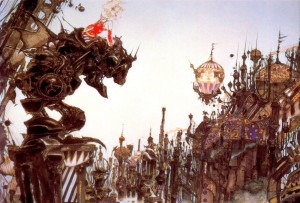In the Autumn of 1994, gamers across North America eagerly awaited the latest installment of the Final Fantasy series. With the surprise disappointment that was the non-release of Final Fantasy V, English-speaking JRPG fans had been waiting three years for a follow up to the 1991 release of Final Fantasy IV. Amongst the many people eagerly awaiting their copy was young(!) Lusipurr.
When, on October 11, 1994, Final Fantasy VI was released, it was met with critical and universal acclaim. Shortages of SNES games were unusual–but shortages of JRPGs were even more so. Yet copies of Final Fantasy VI were hard to find, with many retailers finding themselves in the then-curious position of needing to fulfill demand for a video game that did not feature Mario. Backorders stretched well into the following year thanks to a spirited holiday season. The game made the evening news. It was perhaps the first time in history that a JRPG gained the attention of the North American mainstream press.
Eighteen years later, in 2012, the success of Final Fantasy VI has become the renown of Final Fantasy VI. Routinely featuring in historical “top ten” and “best of” lists, it was this year named by IGN as the number one RPG of all time. Re-released and ported to a variety of systems, it has continued to sell well despite its wide availability on the internet, having surpassed three and a half million copies sold. An announced DS remake was one of the most widely anticipated titles for that system, and when the project was placed on hold, questions were immediately asked about the 3DS instead. To this day, Final Fantasy VI continues to generate headlines. It is simply one of the most beloved games ever made.
Charting the history of a war which will reshape the face of the globe, Final Fantasy VI is ostensibly the story of Terra Branford, the daughter of a human and an esper, whose natural gift for magic attracts the undesireable attention of Gestahl, the emperor of a militarised and technologically-advanced kingdom. Gestahl’s lead researcher, Cid, has devised a means of extracting magical power from espers. This power is used to create magical machines and to give magical power to human beings. With magic at their control, and the military in the command of fearless and valiant generals, the empire of Gestahl seems unstoppable. One by one, the kingdoms and city-states of the world fall against its undaunted might.
As the story opens, a mind-controlled Terra and two soldiers are approaching the colliery town of Narshe where yet another esper has been found. But, the empire’s desire for the esper’s power backfires when the creature, frozen in a block of ice, dispatches the soldiers and breaks the mind-control, freeing Terra from the enslavement of Kefka Palazzo, one of Gestahl’s closest advisors. Her flight is aided by members of the Returners, a resistance organisation which seeks to enlist the assistance of espers in their fight against the empire. Kefka and the entire empire of Gestahl follows in pursuit, intent on regaining their magic-using secret weapon before she turns her power–and vengeance–upon her former captors.
The story follows Terra and her friends as they seek to overthrow the power of Gestahl, Kefka, and those who would seek to use might to enslave the people of the world. Along their way they will be joined by knights, generals, artists, gamblers, and TREASURE HUNTERS, all of whom have their own reasons for resisting the empire’s hegemony. Together, they will face down not only a militarised, magically-armed force, but also a power beyond their comprehension–a power which seeks to rule the entire world as a God enthroned, dispensing death from above without cause or remorse.
Only by uniting and together bravely resisting evil can Terra hope to find salvation for the world and peace for her own, torn soul. Embodying the hopes and prayers of humans and espers alike, the heroes must overcome their own personal struggles before, united, they can defeat the seemingly omnipotent powers which oppose them.
All areas of Final Fantasy VI‘s presentation have been praised since its release nearly a score of years ago. The music (composed by Nobuo Uematsu) is widely considered to be one of the greatest soundtracks ever written for a video game. Its orchestral arrangement–Final Fantasy VI Grand Finale–is still routinely used as an example of the finest in gaming music. The graphics, highly sophisticated for a JRPG of the time, employed numerous cutting-edge technologies: Mode 7 scaling, sampled effects, and highly-detailed environments, some of which are digital renderings of hand-drawn artwork.
Use the comment thread below to discuss your approach to the game, challenges you have faced, tactics you are employing, and what you are getting out of your playthrough. Do you feel that the presentation of Final Fantasy VI has held up since its release in 1994? Are there aspects of the game that you would change, or that you would hold up as an example for modern game developers to emulate? How has your experience with other RPGs released after Final Fantasy VI changed your impressions of the game? Do you have any stories about your first experience? Tell us all about it and join in our discussion below!
The aim in this playthrough is to complete the entirety of the game in four weeks. For the fourth and final week, the goal is to finish the game. Feel free to join in, even if you are behind on the playthrough. Anyone and everyone is invited to participate, regardless of game format, speed of play, or familiarity with the series. Tell your friends!
Without further adieu, it is our very great pleasure to invite you now to join the Lusipurr.com staff members, guests, and readers as we return to the snowy, northern plains in Christmas in Narshe: A Final Fantasy VI Playthrough!




